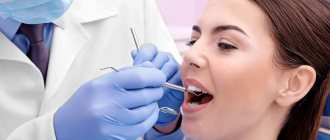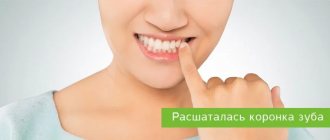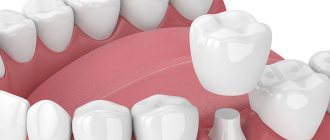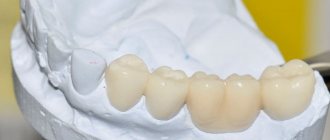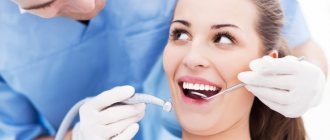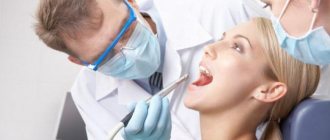Timely detection and treatment of dental diseases is considered a necessary and important condition for maintaining dental health. Even with careful daily oral hygiene, no one can be protected from the development of severe diseases of the teeth and gums, which a preventive examination at the dentist will help identify, because at the initial stage the disease can develop almost asymptomatically.
Experts strongly recommend undergoing a professional examination every six months, even without visible dental problems. Many people are interested in the question: Why exactly after six months? Based on numerous studies, scientists have concluded that this period is optimal for most oral diseases to begin their clinical manifestation. Therefore, they are easy to diagnose and treat because they are in the primary stage of development.
Of course, today the level of dental care is very high, which makes it possible to restore even severely damaged teeth and cope with any ailments of the oral cavity. However, it is better to prevent the disease than to treat it later in a long and tedious manner. Preventive dentistry is designed to recognize pathology in advance and eliminate it as soon as possible.
What is a dental examination?
During the examination, an experienced dentist-therapist, having the appropriate knowledge and the necessary tools, will pay attention to even the slightest changes in the oral cavity, and if pathologies are detected, he will take measures to eliminate the disease.
External inspection includes:
- the condition of the gums is assessed to determine the prognosis of possible diseases;
- determining the correct bite;
- mobility and loosening of teeth is eliminated;
- the condition of previously installed fillings is assessed;
- the enamel of the teeth is examined for caries damage;
- the integrity of dentures and crowns is checked;
- An X-ray examination may be performed (when an image of the teeth is necessary).
After the examination, the doctor makes a conclusion about the presence or absence of dental diseases, and issues recommendations regarding preventive measures or treatment.
Probing
This research method can be carried out to evaluate the reliability and density of the enamel of real teeth and artificial crowns. To do this, the dentist uses an instrument called a probe. With its help, it is possible to determine the presence of carious cavities and the stage of tissue damage. The method is also actively used for the diagnosis of other non-carious diseases, for example, hypoplasia, erosion, fluorosis, etc.
Probing is an absolutely painless and safe process. To check your teeth, the doctor simply needs to run the blunt end of his instrument over the surface of the enamel. This allows you to find irregularities and defects, determine density and hardness. This device can also be used to detect the presence of gum pockets.
Additionally, the dentist can check for gaps between the gum and the crown (or between healthy areas of enamel and the filling material). If there is a severe gap, the filling will need to be reinstalled.
What problems can be identified promptly during a dental examination?
If a visit to the dentist is postponed for an indefinite period, then existing problems may begin to progress, as a result of which more time, effort and money will be spent on eliminating them.
The main dental diseases that are identified during examination in the dental chair include:
- Caries. If caries forms at an early stage, it is possible to cure it in one visit to the dentist. If treatment is not carried out in a timely manner, common complications such as pulpitis and periodontitis may occur, which complicates the preservation of the tooth.
- Gingivitis. Due to the formation of tartar and plaque, this disease begins to progress, which in turn can cause periodontitis, in which inflammation of the soft tissues around the tooth occurs, the ligament of the root and bone is disrupted, and the patient may lose the tooth.
- Periodontal disease. This disease manifests itself in the gradual destruction of periodontal tissue, which can lead to the loss of healthy teeth.
As we can see, the importance of the examination cannot be underestimated; it serves as a kind of starting point for drawing up a further action plan to maintain oral health.
By signing up for a preventive examination, you will receive competent advice and find out all the answers to questions that are of concern to most patients about proper oral care:
- which brush and toothpaste is right for you;
- Are you brushing your teeth correctly?
- what additional hygiene products should be used for prevention purposes;
- how to properly use an irrigator, floss, etc.
Also, if necessary, the dentist can prescribe a number of preventive measures, such as:
- Tartar/plaque removal procedure;
- whitening;
- fluoridation;
- fissure sealing, etc.
Don’t wait until dental problems make themselves known and begin to bother you, because it is much easier to set aside time for a professional examination than to spend days, and sometimes even whole weeks, on grueling treatment.
Palpation and percussion
This technique is used to assess the health of periodontal tissues. To do this, the specialist carefully moves the tooth to the right and left using medical tweezers, checking its mobility and ability to move. If the coronal part moves easily, this indicates the presence of serious inflammation or indicates tissue swelling.
Such consequences can occur due to severe injuries to the jaw, as well as diseases such as periodontitis, periodontitis or periodontal disease. Using palpation, the doctor assesses the degree of pain of the procedure for the patient, because pain can be of varying intensity depending on the complexity of the pathology and its location.
Percussion is a method in which the doctor gently taps the surface of the tooth crowns with a probe or other device. If unpleasant sensations occur with horizontal impacts, this indicates the development of periodontitis; if with vertical impacts, then this indicates an inflammatory process in the pulp chamber. Based on the data obtained, the specialist can make a preliminary diagnosis and send the patient for further examination. Sometimes, during the general examination, an x-ray is prescribed; this is necessary to confirm the diagnosis.
How does plaque affect the health of the oral cavity?
The development of many dental diseases is associated with the appearance of plaque. Harmful bacteria and their decay products have a detrimental effect on the enamel. Over time, plaque hardens and leads to the formation of tartar, which not only causes aesthetic problems, but also destroys the enamel structure and affects the health of the gums. And constantly multiplying microbes and bacteria provoke inflammatory processes and contribute to the progression of the focus of caries development. By causing bleeding and inflammation of the gums, pathogenic bacteria can cause the loosening and subsequently even loss of completely healthy teeth.
During an examination, an experienced dentist may recommend that the patient undergo a procedure for removing tartar and plaque to improve the health of the oral cavity and improve its general condition.
Effective measures to prevent the formation of plaque and tartar include:
- thorough oral hygiene;
- regular dental examinations;
- teeth cleaning at the dentist.
X-ray (digital) examination
The initial consultation with a dentist includes not only a visual examination, but also an examination of the oral cavity with a special apparatus. He takes a photo of the jaws and sends it to the computer. The specialist analyzes the information, makes an assessment and draws up a plan for further treatment. The tooth can be seen from all sides and angles. Defects in both soft and bone tissue are immediately detected. Using an x-ray, you can evaluate the filling of the root canals (if the tooth has already been filled).
Doctors can also use a dental microscope, designed to identify microcracks on the surface of teeth. In dentistry there is a device called an apex locator. It measures the length of the root canals, for example if the patient complains of gum inflammation. Thanks to the indications, the specialist will select the instruments of the required length, which will affect the successful course of treatment.
Orthopantomogram (panoramic image)
You come for an initial consultation with a dentist and voice your complaints. He sends you for an orthopantomogram. The image shows close-up carious changes and inflammation in the soft tissues.
When should you schedule an initial dental consultation?
- You feel discomfort and soreness of the enamel. The surface of the tooth has become more sensitive to hot or cold food. There is a feeling that the tooth is sticking out and getting in the way. The gum or crown is sore.
- You experience a persistent unpleasant odor from your mouth.
- The gloss and color of the enamel began to change. You have found tartar on the surface.
- Mechanical injury to the mucous membrane, gums, and tooth occurred.
Current reasons for seeking an initial examination
- The gums began to bleed, became swollen, and looked pale.
- Acute pain in teeth.
- Visually you see the exposed neck of the tooth.
- Curvature and other abnormalities of teeth.
- Lack of teeth. You will receive an initial consultation with a dentist on prosthetics or implantation.
After an initial consultation and examination, treatment is prescribed and the cost is announced.
Where can you find qualified dental specialists in Ivanteevka?
You can get professional dental care and undergo a preventive examination of the oral cavity at Sanident Dentistry, which provides a full range of services in Shchelkovo and in the urban district of Ivanteevka. We offer affordable prices and high-quality dental treatment. We have the most modern diagnostic equipment, proven painkillers, modern filling materials and instruments.
In our clinic you can undergo such hygiene procedures as: fluoridation, removal of dental plaque, AIR FLOW teeth cleaning, teeth whitening using professional preparations, complete professional oral hygiene and much more.
Entrust your health to professionals, do not allow the disease to enter the active stage of development, prevent the disease in a timely manner. Our experienced professionals are ready to help you with this.
The comprehensive dental clinic "Sanident" is located at the following addresses:
- Ivanteevka, st. Novoselki, 4 (Ivanteevka railway station);
- Shchelkovo, st. Central, 80 (railway station Voronok).
How often do you need to come for a preventive examination to a specialist?
Ideally, you should visit the dentist at least once every six months. However, this recommendation is of a general nature; in each specific case, the frequency of visits to the dental clinic will be determined individually. This depends on the general condition of the oral cavity, predisposition to caries, the general condition of the body, and the financial capabilities of the patient.
Make an appointment
Thank you, your application has been accepted!
If you turn to the InVite Medical clinic for help, our specialist will definitely advise you about future preventive examinations, explain their importance, and set a date for the next visit.
How to make an appointment at the clinic
A consultation with an implantologist is carried out after making an appointment with a doctor - through personal contact or remotely (by phone, through the website or the clinic’s messengers). Some institutions have 24-hour support - you can call or make an appointment at any time. You can contact others only during business hours from 9 a.m. to 6 p.m. When contacting, be sure to tell us about the purpose of the future visit so that an appointment can be made with the right specialist – a dentist-implantologist.
“I was looking for an implantologist based on reviews on the Internet. I re-read the forums and found several good doctors. Then I started looking at the websites of the clinics where they work. Even in the chat on the sites I asked what interests me. Because it’s a front tooth, and I know that they don’t put a crown on just one tooth at once. But they quickly made an appointment for me, literally within a day. And the doctor, after a consultation and x-ray, told me what and how best to do in my case. Everything is very clear and accessible (by the way, the crown can be placed right away).”
Irina P., review from gidpozubam.ru
For middle aged children (5-8 years old)
A detailed verbal account of the reception.
If the child has already grown out of home scenes and cartoons, then it is quite possible to talk to him “like an adult”: tell him what dentists do, and not promise that the child will not feel anything at all. Explain that it may hurt a little, but it won’t last long and for such a big person it’s not scary at all. We can say that taking blood from a finger is much more painful, so since he tolerates this procedure, then an appointment with a dentist is “easy” and not a problem for him.
Authoritative opinion.
The opinion of older children (brothers, sisters, classmates, friends) that dental treatment is not painful and not scary will help. Talk to them, their opinion will be authoritative for your child. Moreover, he will not want to lose face and look like a crybaby in the eyes of his friends, because he will then be asked (at your suggestion) about how the reception went.
A good example.
An excellent way to practically show your child that visiting the dentist is a common occurrence is by example. Let the child come into the office when the tooth of one of the parents or an older brother or sister is being treated. Let him personally ask them about their sensations, listen to sounds that will already be familiar at his appointment. Let him ask the doctor questions (when he finishes work) and, quite possibly, the result will be the child’s desire to sit in the chair and roll up and down.
Of course, it is better to coordinate this point with your treating dentist so that he can better plan his time.
Encouragement again.
You don’t have to directly promise your child “buns and gingerbread cookies,” but to reinforce a positive attitude, casually take a walk to a cafe after the reception, “spontaneously” go to a toy store, “unexpectedly” find out that Aunt Masha has an extra movie ticket... .
